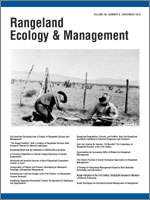A large number of empirical and mechanistic simulation models and decision support tools have been produced for rangelands. Collectively, these models have considerably increased our fundamental knowledge and understanding of the dynamics of ecosystem functions, processes, and structure. We explore three areas where models for rangeland management are often challenging for land managers and enterprise-level decision making: 1) coping with spatiotemporal and climatic variability in implementing scenario forecasting, risk assessments, and adaptive management; 2) addressing outputs of multiple ecosystem goods and services and determining whether they are synergistic or competitive; and 3) integrating experimental and experiential knowledge and observations into decision making. Increasing the utility of models for rangeland management remains a key frontier and a major research need for the modeling community and will be achieved less by further technical advances and model complexity and more by the use of existing topoedaphic databases, the capacity to readily incorporate new experimental and experiential knowledge, and the use of frameworks that facilitate outcome-based, adaptive decision making at the enterprise level with associated economic considerations. Opportunities exist for increasing the utility of models for decision making and adaptive rangeland management through better matching of model complexity with enterprise-level, decision-making goals. This could be accomplished by incorporating a fundamental understanding of herbivory, fire, and spatiotemporal interactions with weather patterns that affect multiple ecosystem functions. Most important, effective models would allow land managers in a changing and variable climate to 1) evaluate trade offs in producing multiple goods and services, 2) optimize the application of conservation practices spatially (comparing costs and benefits accrued across different timescales), and 3) incorporate manager capacity, including experience, skills, and labor input.
Se ha producido un gran número de mecanismos empíricos, modelos de simulación y herramientas para apoyar la toma de decisiones para los pastizales. En conjunto, estos modelos han incrementado considerablemente nuestro conocimiento fundamental y entendimiento de la dinámica de la función de los procesos y estructura de los ecosistemas. Exploramos tres áreas donde los modelos para el manejo de pastizales son regularmente un reto para los manejadores de pastizales y los niveles de toma de decisiones en las empresas: 1) en conjunto con espacio-tiempo y variabilidad climática en la predicción de escenarios, evaluación de riesgos y la implementación de manejo adaptativo, 2) enfocándose a las de salidas de múltiples bienes y servicios de los ecosistemas, y si estos son sinérgicos o compiten entre sí, e 3) integración del conocimiento experimental y experiencial y observaciones dentro de la toma de decisiones. Incrementar la utilidad de modelos para el manejo de pastizales permanece como una frontera clave y una necesidad e investigación muy importante para modelar la comunidad, y se logrará mediante nuevos avances técnicos y menos complejidad de los modelos y más aun mediante el uso de base de datos topoedáficos existentes, la capacidad para fácilmente incorporar nuevos conocimientos experimentales y experienciales, y el uso de marcos de referencia que faciliten los resultados, la toma de decisiones adaptativa en los niveles empresariales con las consideraciones económicas asociadas. Existen oportunidades para incrementar la utilidad de los modelos en la toma de decisiones y en el manejo adaptativo de los pastizales mediante un mejor ajuste de la complejidad del modelo con nivel empresarial y las metas en la toma de decisiones. Esto puede hacerse mediante la incorporación de un entendimiento fundamental de las actividades de los herbívoros, fuego e interacciones espacio- temporales





